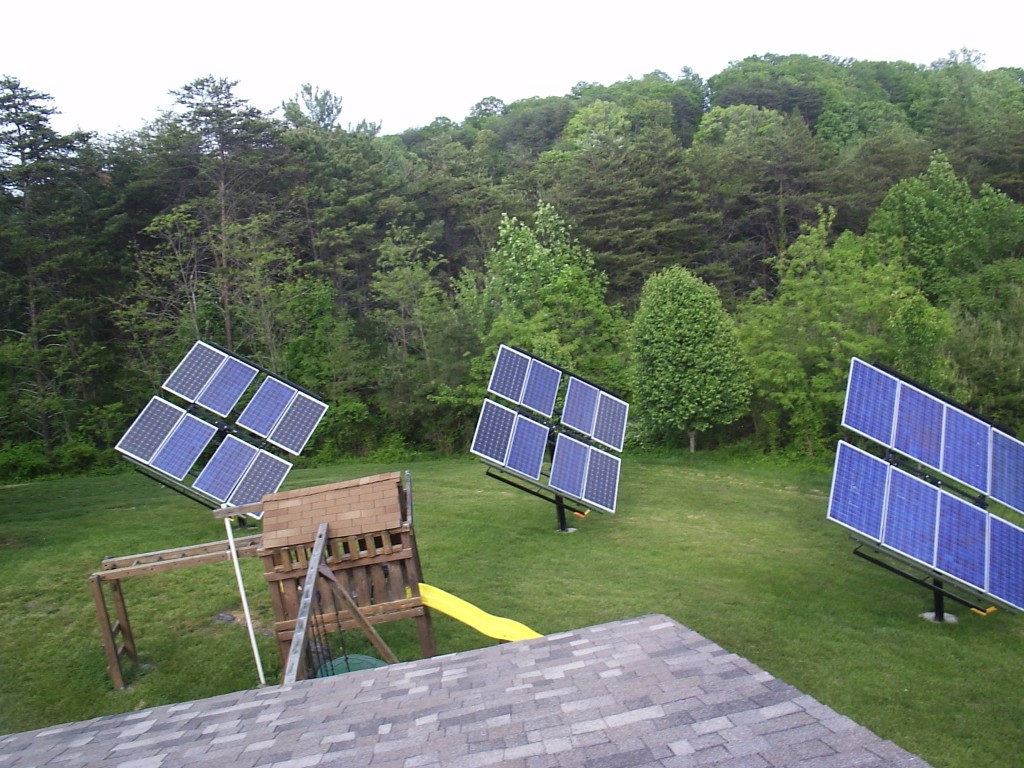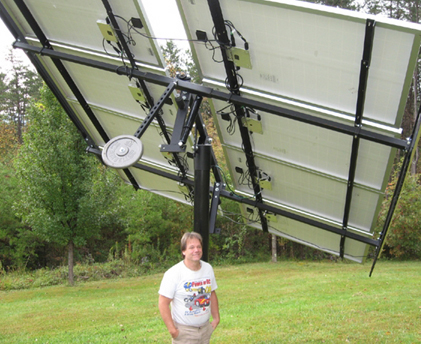SEE REEVA Video by John Carlin news anchor: https://youtu.be/4kqWn2H-rA0
See CONTACT US Page for Club Officers & Contact Info
As a EVA (Electric Vehicle Association) Chapter, you can join the EVA at www.MyEVA.org
Homeowner Solar Project Viability for 1/2 price solar volunteer club help
(materials only $2/W typical vs contractor $4/W):
Over the years, we’ve found for club volunteer assembly, a package of IronRidge 2″ rigid conduit (poles), rails with solar panels in landscape mode (typically 4 panels high) with Enphase MicroInverters and Tier 1 (25 year warranty) panels is the best recipe. If you want something custom that involves a lot of extra effort (cranes, concrete pads etc), then probably out of our scope & best to use a contractor.
1. Our volunteer club will do a solar ground mount array project or 4/12 pitch roof or less.
2. We’re similar to Habitat for Humanity and you need to make less than $150K annually.
3. You must have an accessible driveway that doesn’t require a 4×4 and be within a One Hour driving range of Roanoke, VA
4. You must be a homeowner and willing to obtain your own electrical permit.
Note: this is a CIMA volunteer (liability) insurance requirement although I have an electricians license.
5. Your home must be completed and available to attach solar wiring to.
6. We like you to help with at least 3 solar projects. As a minimum you must help on 3 work days.
Note: I can still help with schematics, general solar info if outside of club help range.
Otherwise you can use one of our solar contractors or similar *LOCAL* contractors.
Reputable Solar Contractors (Google them) have a good BBB rating and 5 star user-reviews rating and are local to your area (Roanoke, VA). They also have a valid master electricians license and DPOR class A or B contractors license with liability insurance.
How would you like to install solar at roughly HALF the cost, 7 year payback instead of 14 years with a contractor? See Solar Project Information Below. The Renewable Energy and Electric Vehicle Association (REEVA) is a Do-It-Yourself club to help members do solar/wind installations and build electric vehicles by helping each other and thus cutting the cost by removing labor. We operate similar to how Habitat for Humanity operates. Future homeowners help with other houses before they start work on their own house. Then volunteers help with their home and they pay for materials and get their house for a fraction of the cost of a brand new house.
Email markehanson1@gmail.com 540-473-1248 to sign up and I’ll email a membership form to return. We like you to help with three projects prior to working on your own.
As you help with other projects, you will learn how to do the installation before you get to your project. We can answer all your questions while you help out such as: How much solar/wind do I need? Which is cheaper, solar or wind (for small projects it is usually solar)? How do I get approved by the utility? Where can I get a loan to pay for the materials?
Also check out Federal Tax Credits Here, copy/paste into your browser:
https://www.irs.gov/credits-and-deductions-under-the-inflation-reduction-act-of-2022
All grid tie projects must have an electrical permit acquired by the homeowner posted prior to REEVA doing any work.
We also promote Wind Farms such as local Poor Mountain (Roanoke) and Beechridge (W-VA) and large scale Renewable Energy Projects.
Note all my RE & EV circuits are on www.evdl.org/lib/mh for public domain.
Our renewable energy future is like a 3-legged stool: residential solar, utility scale wind turbines and electric cars all working together.
How REEVA Began
When REEVA President, Mark Hanson, went on the Solar Home tours and spoke with renewable energy folk’s the main conversation topic was, “Gee the energy (solar/wind) is free but the equipment is expensive.”
A typical turnkey solar grid tie installation is $4 per watt or $15k for a standard 5kw system (without incentives), 30% back from the Fed Tax Credit through Dec 2019. The total parts run about $2 per watt so system cost is *half* about $7.5k with REEVA volunteers helping the homeowner do the labor. It’s best to install on a 25 year roof since the panels and micro-inverters are warranted for 25 years. Some websites say 12.5 years since the shingles last longer under panels. Note, since July 2015 AEP passed a new law that they size a system up front based on the previous 12 month’s usage – so check with them prior to buying parts.
Our Reeva CIMA accident/liability insurance is now $345 and since there are an average of two-four solar/wind systems we need $172 per system prior to starting for insurance reimbursement. If there’s more than two projects per year, the rest will go in the Reeva account for T-shirts, posters etc. Also homeowners requesting help need to help with 3-5 projects prior to the club helping with yours.
I was told that someone should start a club where group member’s help each other to build solar/wind systems and electric cars (that charge on such systems). Thus REEVA was born where volunteers do the labor (like a barn building) and others can see finished projects and learn. (There are also excellent local installers, some are REEVA members who do turnkey projects for folk’s who don’t want to go the DIY route.)
We follow the www.electricauto.org (EAA) bylaws and code of ethics since we are an affiliated club of this 501c3 organization. We also follow the associated www.evdl.org email code of ethics. “Harrasment by or toward any member will not be tolerated”, thus will be dropped from the email list, namecalling or attacking anyone specifically (since email names were voted on to be displayed).
See WWW.PLUGSHARE.COM to add your outlet for EV’s to plug in or to see where to plug in while traveling.
Project websites:
A member’s well documented DIY thermal & PV solar website (Jermy Styles) is http://solarenergyinwv.blogspot.com/
Another PassivHaus we worked on Jason Specht’s house by Adam Cohen, good info is http://passivepreservation.blogspot.com/
Turnkey Solar installations with Mark Howard Master Electrician www.solarpro.com
SOLAR PROJECT SEQUENCE:
Step1 define desired system size from average monthly kWh usage over the past year. If it’s 1300kwh then/30=43.3kwh per day / 4.5 sunny hours = 9.6KWAC. This usually assumes you can go up to 20% over on DC watts for losses (marketing panel peak ratings) to about 11.55KWDC. Nrel pVwatts shows 14% over during operation but 20% is a safe buffer for lifetime 25 years. Panels must face south 180 degrees, and 37 degree incline angle for optimum output efficiency (+-15 degrees, see: NREL PVWatts).
Step2: fill out the 2 Page AEP pre approval form leaving section 5 blank until after final inspection (bases on last 12 months average KWH monthly usage for system size).
Step3: Get your electrical permit with electrical and IronRidge racking mechanical drawings. I usually make the electrical schematic for the inspection office. Permit must be visibly posted for us to help.
Step4: Order Enphase inverters, solar panels and Iron Ridge racking typically from reputable distributor. (technician) figures out the BOM with all the parts. System cost is about $2 per watt (vs $4 per watt with a contractor)
Step5: once parts arrive , club shows up on weekends (sometimes workweek) to assemble, typically 4 weekends Max. Tests system and verify operation.
Step5: Electrical Inspector blesses project, stamps approved on posted permit.
Step6: AEP or utility replaces meter after final form section 5 is filled out with inspectors name and state license number.
Step7: set up online Enphase Enlighten account and Array Builder graphic with bar code label pattern from solar array and verify software data collection is working properly.
Step2: fill out the 2 Page AEP pre approval form leaving section 5 blank until after final inspection (bases on last 12 months average KWH monthly usage for system size).
Step3: Get your electrical permit with electrical and IronRidge racking mechanical drawings. I usually make the electrical schematic for the inspection office. Permit must be visibly posted for us to help.
Step4: Order Enphase inverters, solar panels and Iron Ridge racking typically from reputable distributor. (technician) figures out the BOM with all the parts. System cost is about $2 per watt (vs $4 per watt with a contractor)
Step5: once parts arrive , club shows up on weekends (sometimes workweek) to assemble, typically 4 weekends Max. Tests system and verify operation.
Step5: Electrical Inspector blesses project, stamps approved on posted permit.
Step6: AEP or utility replaces meter after final form section 5 is filled out with inspectors name and state license number.
Step7: set up online Enphase Enlighten account and Array Builder graphic with bar code label pattern from solar array and verify software data collection is working properly.


